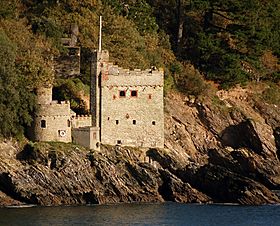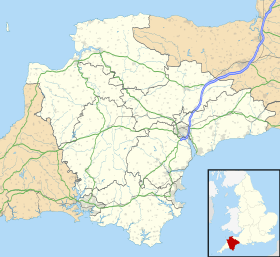Kingswear Castle facts for kids
Quick facts for kids Kingswear Castle |
|
|---|---|
| Devon, England | |

Kingswear Castle, seen from Dartmouth Castle
|
|
| Coordinates | 50°20′29″N 3°33′35″W / 50.34125°N 3.55983°W |
| Type | Artillery tower |
| Site information | |
| Owner | Landmark Trust |
| Open to the public |
No |
| Condition | Restored |
| Site history | |
| Materials | Slate rubble |
| Events | English Civil War |
Kingswear Castle is an old fort built to protect Dartmouth harbour in Devon, England. It was constructed between 1491 and 1502. This was done because people worried about attacks from France. Kingswear Castle was one of the first forts in Britain made specifically for powerful cannons.
However, by the late 1500s, cannons could shoot much farther. This made the castle less important for defence. It played a part in the English Civil War and had cannons until the early 1700s. After that, it became a ruin. In 1855, it was fixed up to be a summer house. Today, the Landmark Trust looks after it, and you can even rent it for holidays!
Contents
Why Was Kingswear Castle Built?
Protecting Dartmouth Harbour
Kingswear Castle was built to protect the important harbour of Dartmouth. In the Middle Ages, Dartmouth was a busy port for trading and fishing. Its harbour, located on the River Dart, could hold many ships.
People were worried about France attacking. So, between 1486 and 1495, the town improved Dartmouth Castle. This castle was on the west side of the river.
Building a New Artillery Fort
Work on Kingswear Castle started in 1491. The goal was to protect the east side of the river's entrance. By 1502, it was finished. This made it one of Britain's first forts built just for cannons.
The castle was a square tower with three floors. It was made from slate stone. It had large, rectangular openings for cannons on the ground floor. These openings were close to the water. They could fire at ships entering the harbour. The first floor also held cannons and rooms for the soldiers.
In the 1570s, a report suggested keeping four brass cannons at the castle. But cannons soon became much more powerful. This meant forts on both sides of the river were no longer needed. By the late 1500s, Kingswear Castle was not as useful for military defence. It was usually not guarded by soldiers.
Kingswear Castle in Times of Conflict
The English Civil War
The English Civil War began in 1642. This was a fight between King Charles I and Parliament. Dartmouth first supported Parliament. The town spent money to make Kingswear Castle's doors stronger.
In 1643, Prince Maurice attacked and captured Dartmouth. An earthwork fort, possibly called Mount Ridley, might have been built behind Kingswear Castle. This would have protected the castle's weak spot. Another idea is that this fort was built earlier, in 1627, and just used again during the war.
In January 1646, Sir Thomas Fairfax led Parliament's army to take Dartmouth back. They captured Kingswear Castle from Sir Henry Cary. Sir Henry was the High Sheriff of Devon and was in charge of defending the castle.
After the War
After the war, Sir John Fowell became the governor. He managed the local defences and stopped smuggling. Sir Henry Cary, who lost the castle, had to pay a large fine.
By 1661, King Charles II was back on the throne. This was called the Restoration. The roof of Kingswear Castle had burned down during the war. A new lead roof was put on, and cannons were placed there. Sir John Fowell stayed as governor. Even though the King briefly gave control of the defences back to the town, the Crown quickly took control again.
By the 1700s, Kingswear Castle was falling apart. However, some cannons were still there in 1717. These included 12-pounder, 9-pounder, and 8-pounder cannons.
Kingswear Castle Today
Restoration and New Uses
In 1855, a businessman named Charles Seale Hayne restored Kingswear Castle. He used a local architect, Thomas Lidstone. The ground floor was changed, and a cone-shaped roof was added. A separate round tower was also built nearby.
During the Second World War, the Royal Marines used the castle. A concrete blockhouse was built to make the site stronger. In 1955, Sir Frederic Bennett bought the castle. He was a Member of Parliament. He made it his home and his office for his local area.
After Sir Frederic retired in 1987, he sold the castle to The Landmark Trust. They changed it into a holiday home. They restored the main building's ground floor to how it looked originally. They also put back the flat, lead roof. Kingswear Castle is now a Grade I listed building in the UK. This means it is a very important historic building.
Images for kids



